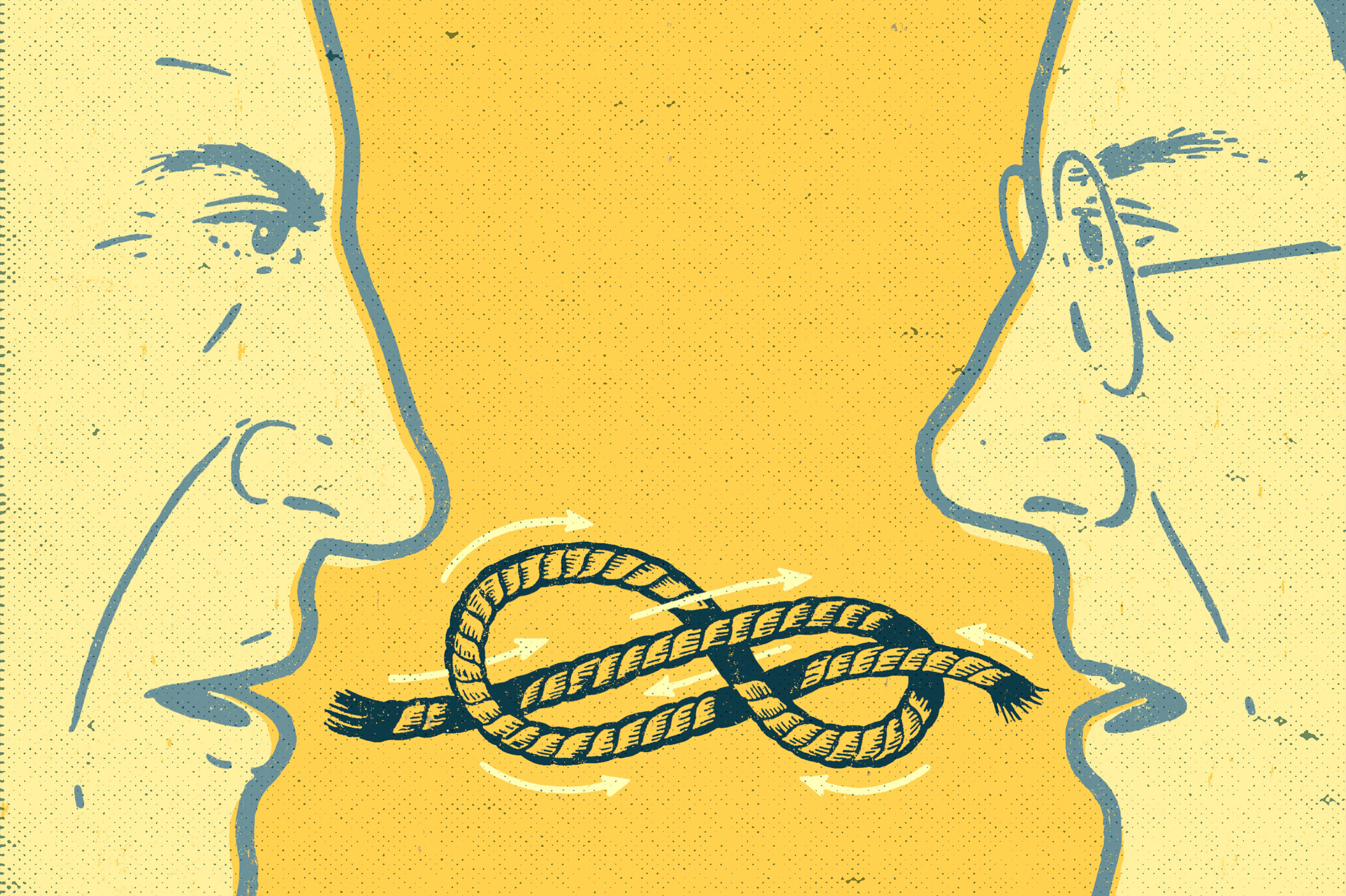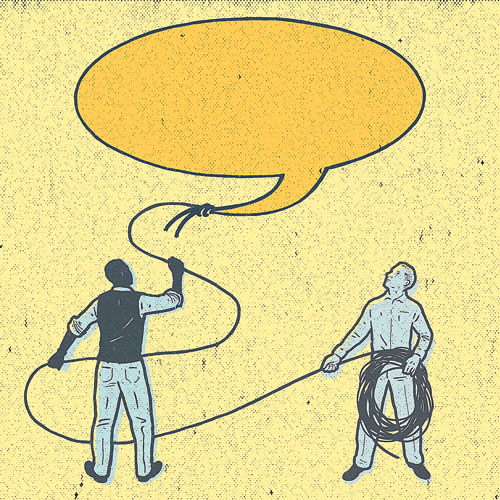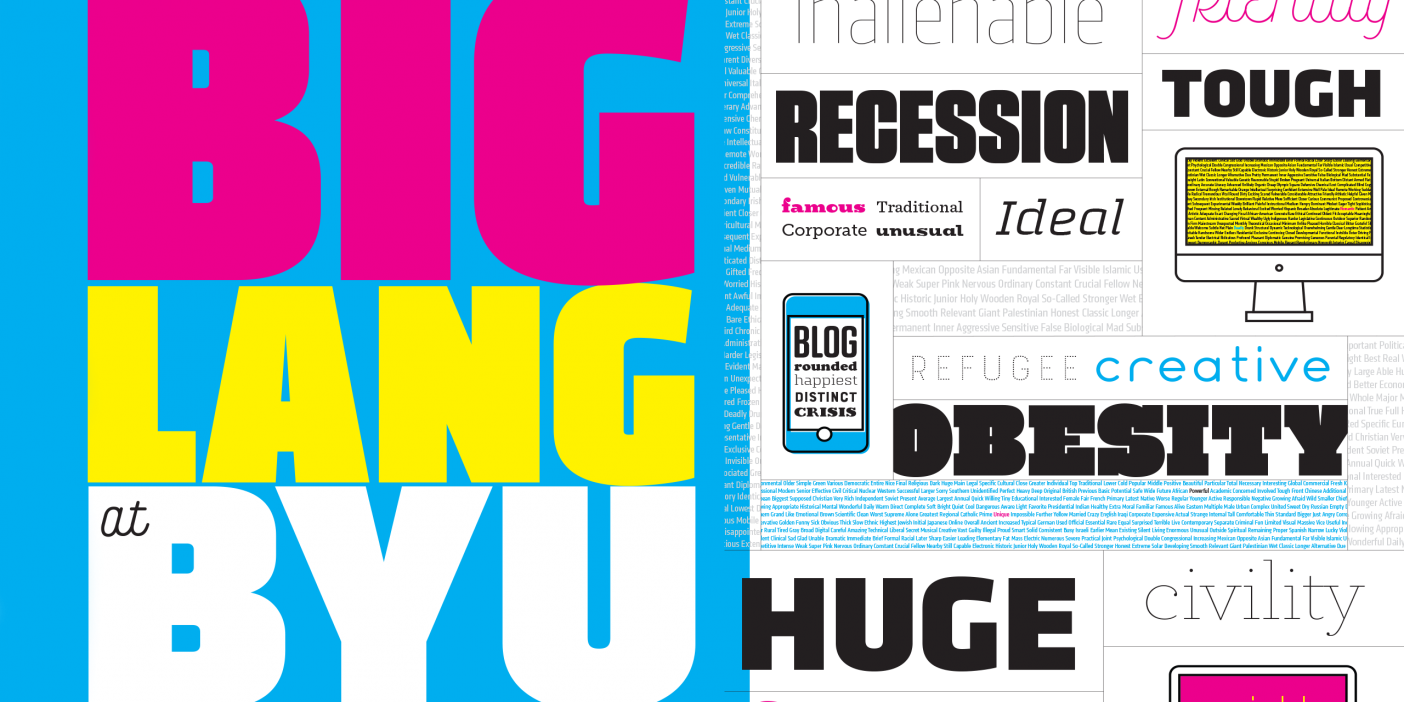We Need to Talk

We Need to Talk
The authors of Crucial Conversations suggest ways to talk yourself into healthier relationships.
By Peter B. Gardner (BA ’98) in the Summer 2010 Issue
Illustrations by Dan Page
Ever caught yourself muttering, “It’s not even worth talking about—it won’t make any difference,” or, “Nothing ever changes around here”? Perhaps you’re entangled in a knotty struggle with your spouse or your boss or your neighbor or your teenager or the employee you supervise, but every time you try to pick apart the problem, you only add new loops to the mess. Maybe you’ve learned just to avoid the problem altogether, feeling in your bones that a tidy resolution is hopeless.
If so, that means that you—like most everybody else—have a problem, a seemingly endless red light on the road to where you wish your business, your family, or your relationship were headed. And, if you ask four BYU alumni and New York Times best-selling authors, the reason you have this problem is likely you.
Not you because you are the source of the problem. And not you because you don’t care. But you because the trouble persists, at least in part, because you haven’t developed the skills—or the will—to resolve it.
As the founders of VitalSmarts, a Provo-based leadership-training and consulting firm, Kerry J. Patterson (BS ’70), Joseph W. Grenny (BA ’89), Ron G. McMillan (MOB ’82), and Al W. Switzler (BA ’71) have made it their mission to give people—from personnel to parents—the skills to stand up to their problems and improve their lives. They teach those skills while consulting and through workshops, and they have written them into three best-sellers: Crucial Conversations and its companions, Crucial Confrontations and Influencer. As their audacious claim states, when it comes to behavior, they really believe you can “change anything.”
“We’re in the interpersonal-skills business,” says Patterson. “We’re teaching people how to handle tough interpersonal issues at the skill level.”

The Path of Dialogue
Karie Willyerd had a problem. In 1997 she was the director of people and organization development for a major division of Lockheed Martin, a Maryland-based aeronautics and defense contractor and one of three companies then ramping up for an all-out effort to win the largest defense contract in history. The Joint Strike Fighter was to be a huge leap forward in military-jet technology and sophistication, including short-takeoff and vertical-landing capabilities. To make a bid, the companies had to develop working prototypes that might cost billions to create and require some 10,000 engineered systems to interact seamlessly.
Trouble was, Lockheed Martin, like many companies, had plenty of room for growth in employee interaction, which, if not improved, might lead to productivity problems and jeopardize the company’s bid for the $200 billion contract.
As Willyerd worked with executives on an initiative to improve company performance, a colleague tipped her off to VitalSmarts, which she enlisted to diagnose Lockheed Martin’s problems and provide training.
To figure out what was at the heart of the trouble, Grenny and Switzler flew in to meet with company executives and scheduled a series of focus groups. But rather than run the focus groups themselves, the VitalSmarts consultants trained the execs to do it, a move Willyerd calls “brilliant.” “If it’d been HR coming in and saying, ‘Here’s what the focus group said,’ [company leaders] could go into denial really easily,” she says. “But when they’ve heard it themselves . . . , you can’t keep them from leaving the room and taking action.”>
What Lockheed Martin president Dain Hancock and other executives heard in the focus groups was a description of a very hierarchical culture in which engineers felt punished by their superiors for offering differing points of view or sounding alarms when they saw design problems. Workers had learned to keep their mouths shut, forge ahead on flawed designs, and wait for the inevitable realization that the idea, literally, just wouldn’t fly.
Grenny and Switzler weren’t surprised to find communication trouble at the root of Lockheed Martin’s problem. Businesses typically contacted VitalSmarts for help to improve productivity by, say, teaching analytical problem-solving techniques. But when the consultants raised the magnifying glass to the companies’ business cultures, they often found that productivity concerns were only symptomatic. “If it was a particularly unhealthy organization,” says Patterson, “they’d be screaming and yelling at each other, abusing, not listening, using inappropriate humor, sexist behavior. I’d say, ‘Before we get to the analytical problem solving, maybe we ought to work on how we talk to each other.'”
And most often, they’d focus on a particular type of talking—what they call crucial conversations. Conversations are crucial when stakes are high (think $200 billion contract on the line), opinions vary (execs vs. engineers), and emotions run strong (“They don’t respect my opinion”). Despite best intentions, most of us—whether we’re engineers questioning a critical design, supervisors confronting underachieving employees, or parents responding to defiant teens—tend to botch our most important conversations.
As McMillan likes to say about family situations, “We find that parents want to help their children in the worst way, and that’s the way they help—the worst way: This is such an important conversation with my kid, and I end up yelling and screaming and grounding him. Then I wonder why he won’t open up to me, won’t talk to me.”
Our trouble, they say, is largely physiological. When a conversation becomes crucial, adrenaline begins to flow, our reasoning functions start shutting down, and a fight-or-flight response kicks in. The VitalSmarts team calls this reaction “violence vs. silence.” Those of us who respond to tense interactions with violence, they say, tend to overstate arguments, make hurtful accusations, raise voices, and otherwise say things we later regret.
Others, like the Lockheed Martin engineers in 1997, choose silence, seeking safety by saying nothing when something needs to be said. The trouble with silence is that problems go unresolved and resentment lurks just below the surface. The VitalSmarts crew has found that those of us who opt for silence typically act out frustration through moodiness or outright subversion until we eventually erupt into a “violent” tirade.
We tend to assume it’s a doomed either-or scenario: either confront the problem and experience undesired results in the relationship, or endure the problem to preserve the relationship. The VitalSmarts team preaches that there’s another option, a path by which it’s possible to do both—take on the toughest interpersonal problems while maintaining a safe, respectful environment that builds relationships.
“You can’t fix anything until you can talk about it,” says Switzler. And you certainly can’t build the next generation of fighter jets.
At Lockheed Martin, VitalSmarts prescribed company-wide training in their Path of Dialogue skills development course, which would become the basis for their first book, Crucial Conversations: Tools for Talking When Stakes Are High.
So was it effective? In follow-up studies, not only did employees report a safer environment to speak their minds, but the company’s internal metrics showed that designs were reworked less often. Oh, and they went on to win the largest contract in history. “That [the bid] was successful has to be because of having a team that could communicate around a complex piece of equipment,” says Willyerd.
One more evidence that crucial conversations training had an influence: Willyerd says Lockheed Martin employees used to tease the HR group for their “initiative of the month.” But 13 years later, and 10 years after Willyerd left for another job, the company is still advocating the power of crucial conversations.
From the Board Room to the Breakfast Table
By the time VitalSmarts lent a hand at Lockheed Martin, they’d been learning from and assisting organizations for many years. The four founders held their first meeting in a VW van in 1990. Switzler and Patterson had taught in BYU’s then-nascent master’s of organizational behavior program in the 1970s and later partnered with McMillan in another consulting venture. Before forming VitalSmarts, McMillan and Grenny had worked together at the Covey Leadership Center.
While working there with his former BYU organizational behavior professor Stephen R. Covey (DRE ’76), McMillan says they found that those who attended their training seminars divided roughly into thirds: those who had changed their lives significantly, those who had applied the training to a few aspects of life, and those who “hadn’t done anything with it but felt really guilty about it.”
It was that guilty third that the VitalSmarts founders had in mind as they organized. Their focus was building high-leverage skills in those for whom principle-based change doesn’t come naturally.
As the four worked over the next several years on long-term change efforts with dozens of large organizations—from Allstate and AT&T to Ford and departments of the U.S. government—they learned nearly as much as they taught. With the partners constantly gleaning real-life lessons from troubled businesses, various training programs, complete with video-based examples, began to take shape. “We would all come back very rich with ideas that were working and those that were not,” says McMillan. “It was incredibly synergistic.”
They soon noticed an interesting trend. They’d teach business professionals a specific skill one week, then give them an assignment to practice it before the next week’s training. “Invariably, they’d go homeand practice,” says Patterson. “One, it was safer than confronting the boss if it was a confrontation skill; or, if nothing else, they had more opportunities. If you have teenagers, you have maybe 30 opportunities in an evening.”
This trend led them to begin including family interactions in their books and video-based examples. The approach drew the ridicule of some in the organizational-behavior field “for taking something as important as business and bringing family to it,” says Patterson. But, he counters, “you hire the whole person. Employees go home at night, and they have family experiences, roommate experiences, andcommunity experiences. We’re trying to train the skills that would help with all domains.”
Karie Willyerd says the training she received while at Lockheed Martin had a far-reaching effect: “It’s not inappropriate to say that it changed my life.” She implemented similar training at two subsequent jobs and passed on her enthusiasm to her daughter, who took the Crucial Conversations course and now uses it as a neonatal intensive-care nurse.
Lockheed Martin president Dain Hancock was so impressed by the trainings that he sponsored his direct-report employees and many of their spouses in a Crucial Conversations skills workshop.
McMillan notes that he and the rest of the VitalSmarts brain trust are not immune to interpersonal challenges or beyond benefitting from these skills. He winces as he cites his own painful divorce after 20 years of marriage and five children. “I really thought that I could fix any relationship problem, and here in the most important relationship of my life, I failed,” he says. “That was a huge tragedy in my life.” Later, when he met and married a woman with four children of her own, she took the training, and they soon found that the skills McMillan had discovered studying organizations were more than applicable in a family merger. “For me, that was the richest payoff of all—being able to blend those two families. I just don’t know how I would have done it without the things I’ve learned from our clients and the studies here.”
Confronting Your Problem
So, back to your problem—the sticky one with your boss or your neighbor or your spouse or your teen. You’d like the situation or relationship to improve, but what can you do and say that won’t just make things worse? The VitalSmarts team has a book’s worth of suggestions, but here are a few points for starters:
First, it’s important to remember that because a resolution to the concern will require a crucial conversation (high stakes, differing opinions, and high emotions), your body will likely give you all sorts of less-than-helpful suggestions on how to handle it. That’s why the authors say you need to temper your adrenaline with a dose of rational thinking.
The first step, then, is to take a long look in the mirror, or, as the authors put it, “start with heart,” meaning your own. Before you are ready to dive into a discussion about a touchy issue, it’s important to acknowledge your possible complicity in it and to consider your motives for having the conversation. Are you merely trying to score points in an ongoing intraoffice contest of wills, or are you committed to finding the best solution for all parties? Are you speaking up about your child’s behavior out of annoyance or out of love and concern? (See “Vital Skills: Me First!” below.)
Of course, what makes crucial conversations difficult is that, whatever your intentions, nobody likes to receive negative feedback. In the face of a critique, we naturally either withdraw or put up our dukes (silence or violence). When you bring up your concern about your spouse’s spending habits, he or she may get defensive, stare at the floor, or show other signs of feeling emotionally unsafe. The authors argue that without safety, there’s little chance of the conversation going anywhere productive; on the other hand, if safety can be preserved, people can talk candidly about almost anything. (See “Vital Skills: Play It Safe,” below.)
And what about your own emotions? How will you respond if the other person takes your feedback with, let’s say, less than good cheer or turns the table with a critique of his or her own? To control our emotions, the authors say, it’s essential that we scrutinize the one-sided stories we tell ourselves that give the emotions life (for instance, “He’s resistant because he doesn’t respect my authority as his boss”). We’d be wiser, says McMillan, to trade our story for a question—”Why would a reasonable, rational, decent person act that way?”—and seek understanding.
Once the environment is safe and emotions are in check, the stage is set for a discussion exploring the concern, the other person’s perspective, and possible strategies to move forward. The authors say the goal is to keep dialogue open until all perspectives have been added to the “Pool of Shared Meaning.” The more information in the pool, the more to draw from in reaching the best outcome. (See “Vital Skills: Filling the Pool,” below.)
Handling such conversations may still feel out of reach; McMillan suggests you start small. “Minor adjustments in the way you say things can make a huge difference.”
Nice Cultures and Building Zion
If the whole idea of addressing your tough issue makes you feel a bit squeamish, the VitalSmarts team says it might be because you are part of what they call a “nice culture.”
Patterson says different “subcultures deal with potentially risky conversations very differently.” In New York or Great Britain, for instance, it’s not uncommon for people to speak their minds—often bluntly. But they say that in places like Asia, Minnesota, Georgia, and Utah—where nice cultures rule—people are much less likely to express concerns or seek resolutions to difficult problems. In a nice culture, “if I express my opinion and it’s not a favorable opinion or it’s a differing opinion, I’m being rude,” says Patterson.
“We mistake politeness for respect,” McMillan adds. “Sometimes the most respectful thing is to tell you what you need to hear even if it’s hard to hear.”
They argue that we needn’t be confined to being either candid or respectful; with the right skills, they say, it’s possible to be both. Being both honest and kind is critical if we hope to bridge divides and create unity in our families, workplaces, and communities, an endeavor with both temporal and spiritual significance.
Grenny notes that unity—achieving oneness of heart and mind—doesn’t just happen on its own. It takes conversations, some of them crucial, and it takes negotiation. “What will it take for us to build Zion?” he asks. “I don’t think that’s any different than the question, What does it take to build a healthy organization of any kind?”
Vital Skills: Me First!
The VitalSmarts team says that, when seeking to improve a relationship or situation through a crucial conversation, the place to start is with yourself. Here are a few pointers for getting your heart in theright place:
* First, take an honest look at your own behavior. “More often than not, we do something to contribute to the problems we’re experiencing,” the Crucial Conversations authors write. Remember, you’re the only person you can actually control.
* Examine your motives. “‘Getting your heart right’ is a simple mental skill where I say, ‘What do I really want? Do I want to shame you? Do I want to defeat you in a debate? Do I want to win an argument? Or do I want to deeply understand you?'” says VitalSmarts cofounder Ron G. McMillan (MOB ’82).
* After determining what you really want to achieve (and what you really don’t want), ask yourself, “How should I behave if I want these results?” and, “What will I not do and say to avoid needless offense and misunderstanding?”
* Monitor your emotions and responses as the conversation progresses to make sure you aren’t derailed from what you really want to have happen.
Vital Skills: Play It Safe
A feeling of safety, say the VitalSmarts experts, is the most essential, and perhaps most elusive, element of an effective crucial conversation. Here are some ideas for promoting—or returning to—safety in a touchy interaction:
* Agree on a mutual purpose for the conversation—a reason for having it that benefits both parties.
* Choose your words and gestures carefully. Don’t show disrespect by using sarcasm or overstating your point. Don’t roll your eyes or clench your fists threateningly.
* Be on the lookout for signs that others feel threatened, such as anger, sarcastic remarks, avoiding the topic, or sulking.
* When negative emotions arise, step out of the conversation (the content) long enough to restore safety (the context). Focus less on what someone says or does and more on what it means. (He’s defensive because he feels attacked. She’s staring at the floor because she’s embarrassed.)
* If you’ve done something hurtful to the other person, offer a heartfelt apology. Show that you’re willing to deal with your part of the problem.
* Use contrasting to clarify. Often people will misunderstand the scope of a critique. Get things back on track with don’t/do statements. (“We don’t want you to think we mistrust you. You’re a great daughter. We do want to talk about you disobeying the curfew.”)
Get Influence: Overwhelm or Be Overwhelmed
Imagine you drive an SUV, but your Hummer ain’t humming. You call on a friend to give a push, but the vehicle won’t move. So you ask another to try, but it won’t budge for her either—or for any of your other friends. It would be wiser, says VitalSmarts cofounder Kerry J. Patterson (BS ’70), to enlist all of your friends to push in unison.In 20 years of studying businesses trying to change, the VitalSmarts crew has found that the most daunting organizational challenges rarely give way to the force of one initiative. After all, these challenges feel overwhelming for a reason. They discovered that the most influential managers marshal every source of influence they have in an all-out struggle, thus “overwhelming an overwhelming problem.”
As described in their most-recent book, Influencer: The Ability to Change Anything (with VitalSmarts colleague David Maxfield as an additional author), the authors identify six sources of influence—such as positive peer pressure, altering the environment, and a system of rewards and accountability—that improve either the motivation or the ability to achieve the desired outcome. They have shown that organizations are up to 10 times more successful in changing critical behaviors if they enlist four or more sources of influence, rather than just one.
In Change Anything, a book to be released next year, the authors set loose these sources of influence on personal problems—from weight loss to addictions to financial mismanagement. For instance, they know that if you make friends aware of your goal to stick to a diet, you up your chances of success by about 20 percent. Put money at risk (maybe $10 goes to an organization you don’t support every time you snitch), and you boost the likelihood 10 to 15 percent more.
Joseph W. Grenny (BA ’89) says Change Anything will be complemented by an array of Web 2.0 tools: “This will be an integrated part of people’s lives. We’ll use texting, social networking, incentives, and everything we know about social science to help you change.”
Vital Skills: Filling the Pool
Crucial conversations work best when both parties are willing to share perspectives and insights about the concern, adding to what the VitalSmarts experts call the Pool of Shared Meaning. Here are some pointers for adding—and encouraging others to add—to that pool:
* Start with facts instead of accusations or value-laden labels. (“You’ve been late to each of our last three team meetings” instead of “You don’t care about other people’s time” or “You’ve been a slacker.”)
* When drawing conclusions about another person, use tentative—but not wishy-washy—language. (“It is starting to appear that your lateness is becoming a habit.”)
* Make it clear that you may not understand the situation perfectly and that you don’t have all the answers. Ask a question to invite another perspective. (“Am I misunderstanding the situation?” or “How do you see things?”)
Feedback: Send comments on this article to magazine@byu.edu.





